Faberge may be known for their stunning eggs, but they have also made a name for themselves in the jewelry industry with their extraordinary craftsmanship in the art of enameling. More information on the laboriously, tedious processes required in perfecting detailed enamel jewelry can be found
here.
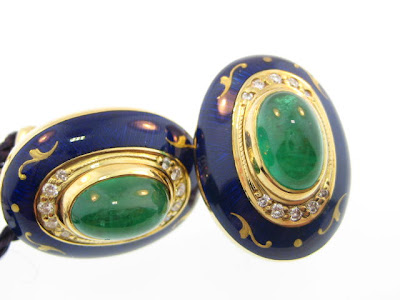
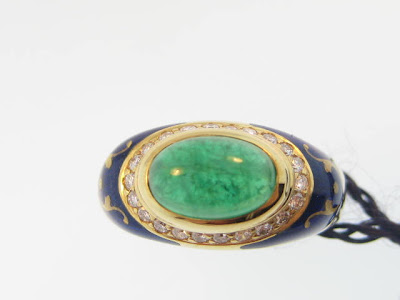
The oval red rubies in this Faberge ring and earring are accented with diamonds and a beautiful red enamel

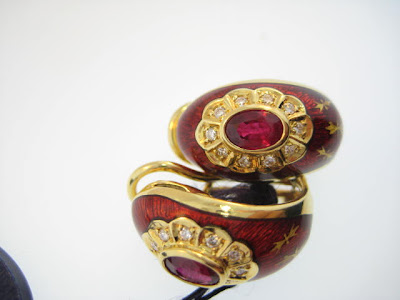
This is an elegant Faberge blue sapphire and blue enamel necklace available at Handiwork Jewelry in Memphis, TN


Ways to ensure it is an authentic Faberge enamel piece is to look for tags and stamps
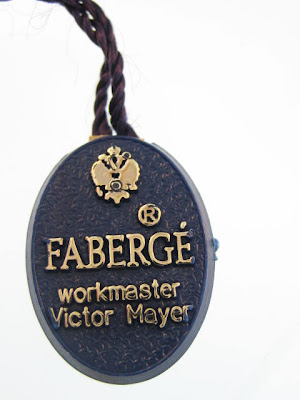
In the clasp of the sapphire, blue enamel necklace, you will see the trademark stamp and 750 imprint to indicate it is 18 white gold

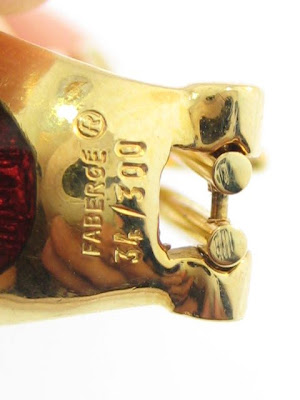
About Faberge
In 1872, Peter Carl Faberge took over his father's jewelry workshop, which had been established in St. Petersburg in 1842. His technical mastery as a goldsmith put him on par with the world's most renowned jewelers. He drew his inspiration from the art of earlier generations which he found in the well-stocked treasury of the Hermitage. As Supplier to the Imperial Court of Russia, Faberge is best known for his unique series of 50 jeweled Imperial Easter eggs dating from 1885-1916. His patrons included most of the world's royalty and other wealthy clientele of his time.
Faberge's creative genius and his quest for originality, combined with his supreme technical mastery are the hallmarks of his distinctive style. His immensely popular Objects of fantasy can be seen in some of the world's most important museums and private collections. Outstanding among these are the collections of H.M. Queen Elizabeth II and Forbes Magazine.
After the 1917 October Revolution, Faberge fled Russia. All of the assets of the Faberge company located within Russia had been confiscated by the new government. Peter Carl Faberge died in Lausanne, Switzerland in 1920.
The famous jeweler to the Tzars, Peter Carl Faberge, used so called "Work masters" to create his wonderful objects of art. The Faberge Company, then in St. Petersburg, now has offices in London, Paris, and New York, to continue this tradition.
In 1990 the Faberge Company appointed the jeweler Victor Mayer GmbH & Co. of Pforzheim, Germany, founded in 1890, as the new and exclusive work master. This firm was chosen because throughout more than 100 years it has continued to maintain the essential manual skills and technical knowledge necessary for the continuation of Faberge's legacy. Under one roof 60 craftsmen exercise more than 30 traditional skills - some of them unique to this firm.
Victor Mayer of Pforzheim, Germany is the only Work master in the world that has been entrusted with the license to produce and sell Faberge Company enameled 18k gold jewelry. Every item created is an original work produced in a limited edition and bears the coveted "FABERGÉ" hallmark and the mark of work master Victor Mayer.
The family owned enterprise, Victor Mayer GmbH & C, was founded in 1890 and is one of Europe's leading producers of handmade jewelry. In more than 30 countries the name of the company founder is synonymous with the craft of the German goldsmith. Creations from Victor Mayer are the result of an unusual combination of tradition and innovation. Their greatest asset is an archive of designs, models, and workbooks as well as specialty tools and equipment from 110 years of company history. Thanks to the knowledge handed down to the fourth generation, the craftsmen at Victory Mayer are able to use rare techniques of the goldsmith's art to produce incomparable jewelry and objects of art for Faberge.




